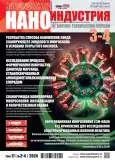Исследование процесса формирования наночастиц диоксида марганца, стабилизированных алкилдиметилбензиламмония хлоридом
- Авторы: Нагдалян А.А.1, Блинов А.В.1, Кравцов А.А.1, Закаева Р.Ш.2, Леонтьев П.С.1, Тараванов М.А.1, Сенкова А.О.1
-
Учреждения:
- Северо-Кавказский федеральный университет
- Северо-Осетинская государственная медицинская академия
- Выпуск: Том 17, № 3-4 (2024)
- Страницы: 230-239
- Раздел: Наноматериалы
- URL: https://journals.eco-vector.com/1993-8578/article/view/633091
- DOI: https://doi.org/10.22184/1993-8578.2024.17.3-4.230.239
- ID: 633091
Цитировать
Полный текст
Аннотация
Образцы наноразмерного диоксида марганца, стабилизированного алкилдиметилбензиламмония хлоридом, получали методом химического осаждения. В ходе оптимизации было выявлено, что для синтеза наночастиц диоксида марганца со средним гидродинамическим радиусом менее 1200 нм оптимальными параметрами синтеза являются: температура от 20 до 35 °С, масса KMnO4 от 4 до 5 г и концентрация стабилизатора от 4 до 5%. Исследование образцов методом сканирующей электронной микроскопии показало, что образец наноразмерного диоксида марганца, стабилизированного алкилдиметилбензиламмония хлоридом сформирован агрегатами неправильной формы размером от 1 до 75 мкм, которые состоят из наночастиц диаметром от 50 до 250 нм. Методом рентгеновской дифрактометрии исследована структура и установлено, что полученный образец обладает тетрагональной кристаллической решеткой, имеющей пространственную группу I4/m; о присутствии данной фазы говорит наличие слабоинтенсивных уширенных пиков. В результате анализа данных, полученных при моделировании взаимодействия молекулы алкилдиметилбензиламмония хлорида и оксида марганца через азот установлено, что представленные соединения являются энергетически выгодными (∆E = 1299,571 ккал/моль), а взаимодействие происходит через азот. Данное соединение обладает значением химической жесткости η ≥ 0,030 эВ, что свидетельствует о его стабильности. В результате анализа ИК-спектров алкилдиметилбензиламмония хлорида и наноразмерного диоксида марганца, стабилизированного алкилдиметилбензиламмония хлоридом, можно сделать вывод о том, что взаимодействие между алкилдиметилбензиламмония хлоридом и диоксидом марганца происходит через азот.
Полный текст
Об авторах
А. А. Нагдалян
Северо-Кавказский федеральный университет
Автор, ответственный за переписку.
Email: anagdalian@ncfu.ru
ORCID iD: 0000-0002-6782-2821
кандидат технических наук, доцент
Россия, СтавропольА. В. Блинов
Северо-Кавказский федеральный университет
Email: anagdalian@ncfu.ru
ORCID iD: 0000-0002-4701-8633
кандидат технических наук, доцент
Россия, СтавропольА. А. Кравцов
Северо-Кавказский федеральный университет
Email: anagdalian@ncfu.ru
ORCID iD: 0000-0002-0645-1166
кандидат технических наук, доцент
Россия, СтавропольР. Ш. Закаева
Северо-Осетинская государственная медицинская академия
Email: anagdalian@ncfu.ru
ORCID iD: 0000-0002-9930-6055
кандидат химических наук, доцент
Россия, ВладикавказП. С. Леонтьев
Северо-Кавказский федеральный университет
Email: anagdalian@ncfu.ru
ORCID iD: 0000-0001-6532-5816
лаборант
Россия, СтавропольМ. А. Тараванов
Северо-Кавказский федеральный университет
Email: anagdalian@ncfu.ru
ORCID iD: 0000-0003-3243-3241
лаборант
Россия, СтавропольА. О. Сенкова
Северо-Кавказский федеральный университет
Email: anagdalian@ncfu.ru
ORCID iD: 0000-0002-6615-2563
студент
Россия, СтавропольСписок литературы
- Барсукова В.С. Физиолого-генетические аспекты устойчивости растений к тяжелым металлам / Экология. Серия аналитических обзоров мировой литературы. 1997. № 47. С. 1–67.
- Chetri K. Role of trace elements in hepatic encephalopathy: zinc and manganese / K.Chetri G.Choudhuri / Indian Journal of Gastroenterology: Official Journal of the Indian Society of Gastroenterology. 2003. V. 22. PP. 28–30.
- Bowman A.B. et al. Role of manganese in neurodegenerative diseases / Journal of Trace Elements in Medicine and Biology. 2011. Vol. 25. No. 4. PP. 191–203.
- Бобренко И.А., Вакалова Е.А., Гоман Н.В. Эффективность опудривания семян микроэлементами (Zn, Cu, Mn) при возделывании яровой пшеницы в условиях лесостепи Западной Сибири / Омский научный вестник. 2013. № 1 (118). С. 166–170.
- Кабата-Пендиас А. Проблемы современной биогеохимии микроэлементов // Российский химический журнал. 2005. Т. 49, № 3. С. 15–19.
- Жуйков Д.В. Мониторинг содержания микроэлементов (Mn, Zn, Co) в агроценозах юго-западной части Центрально-Черноземного района России / Земледелие. 2020. № 5. С. 9–13.
- Qian J.H. et al. Phytoaccumulation of trace elements by wetland plants: III. Uptake and accumulation of ten trace elements by twelve plant species / American Society of Agronomy, Crop Science Society of America, and Soil Science Society of America, 1999. Vol. 28, no. 5. PP. 1448–1455.
- Abbas S.T. et al. Trace elements accumulation in soil and rice plants irrigated with the contaminated water // Soil and Tillage Research. 2007. Vol. 94, no. 2. PP. 503–509.
- Koyama M. et al. Trace elements in land plants: concentration ranges and accumulators of rare earths, Ba, Ra, Mn, Fe, Co and heavy halogens // Journal of Radioanalytical and Nuclear Chemistry. 1987. Vol. 112. PP. 489–506.
- Акентьева М.И. Влияние марганца на рост и развитие растений // В сб.: Успехи молодежной науки в агропромышленном комплексе, 2022. С. 5–15.
- Панин М.С., Королев А.Н. Влияние марганца на молодые растения яровой пшеницы // Агрохимия. 2007. № 1. С. 68–77.
- Клышевская С.В., Тимофеева Я.О., Бурдуковский М.Л. Влияние использования удобрений на накопление марганца сельскохозяйственными культурами // Вестник Дальневосточного отделения Российской академии наук. 2014. № 5 (177). С. 72–77.
- Водяницкий Ю.Н. Минералогия и геохимия марганца (обзор литературы) / Почвоведение. 2009. № 10. С. 1256–1265.
- Пальчик Н.А. и др. Состав и структура марганцевых минералов пресного озера Миассово // Журнал неорганической химии. 2014. Т. 59, № 5. С. 681–681.
- Каримбекова А.М., Муратов А.С., Джанмулдаева Ж.К. О возможности получения марганецсодержащего удобрения на основе аммофосфата // Научные труды ЮКГУ им. М. Ауэзова. 2016. № 4. С. 41–43.
- Рабинович Г.Ю., Любимова Н.А. Биосинтез наночастиц металлов и оксидов металлов и их использование в качестве компонентов удобрений и препаратов для растениеводства (обзор литературы) // Аграрная наука Евро-Северо-Востока. 2021. Т. 22, № 5. С. 627–640.
- Бондарева Т.Н., Дмитренко Н.Н., Шеуджен А.X. Влияние воздушно-теплового обогрева и обогащения Мп семян риса на рост, развитие и фотосинтез растений // Агрохимия. 2005. № 10. С. 53–58.
- Лебухов В.И., Окара А.И., Павлюченкова Л.П. Физико-химические методы исследования. 2012.
- Блинов А.В. и др. Моделирование процессов стабилизации наночастиц MnO2 // В сб.: Актуальные проблемы инженерных наук, 2018. С. 445–446.
- Ata M.S., Zhitomirsky I. Electrophoretic nanotechnology of ceramic films // Advances in Applied Ceramics. 2012. Vol. 111, no. 5–6. PP. 345–350.
- Alghamdi M.A.G. Biomaterial approaches for Glioblastoma therapeutics: дис. Cardiff University, 2022.
Дополнительные файлы










